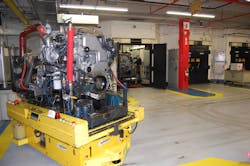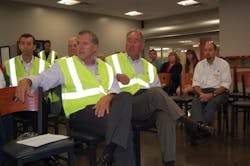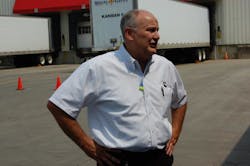“Re-orientation” key challenge facing diesel engine design efforts
Perhaps the biggest challenge facing the diesel engine business today is “re-orienting” design efforts away from a focus on exhaust emissions to fuel economy, performance, and component integration – not only to meet U.S. mandates regarding greenhouse gas (GHG) emissions but to meet motor carrier demands for more powerful and more efficient engine models.
“That’s the challenge for us going forward as we come out of a long period where we focused primarily on meeting particulate [matter] and NOx [oxides of nitrogen] emissions,” Dave Crompton, president of the Cummins Engine Business division at Cummins Inc., explained to Fleet Owner during the 40th anniversary celebration for its Jamestown Engine Plant (JEP) located near Jamestown, NY, last week.“Now we must concentrate more of fuel economy and system integration to enhance performance, along with meeting increased demand,” Crompton added, seen here in the front row at left in the photo at right next to Jim Kelly, who served as president of the Cummins Engine Business from 2005 to 2010.
The JEP facility currently builds more than 500 mainly on-highway engines every day, according to Mike Kosinski, assistant chief of product engineering at the plant – some 400 15-liter models, 50 or so 12-liter variants, and 50 ISM units that are exported outside of the U.S. with a goodly number headed to Mexico.
Two production lines run side-by-side at JEP, Kosinski noted – one dedicated to 15-liter engines and the other handling 12-liter and ISM units. And he stressed that there’s almost no “segmentation” by engine type on the manufacturing line handling the 12-liter and ISM models; they are all mixed together, which includes the Cummins Westport ISX12 G spark-ignited natural gas engine.
Mike Abbate, JEP’s plant manager, described this highly customized engine building process as the “hamburger method.”“The base elements of a [diesel] engine are the block and crankshaft – analogous to the hamburger patty and bun,” he explained. “But from there, every hamburger is different: some customers want cheese, pickles, and tomatoes, while others might want onions, mustard, and bacon.”
With engines, Abbate (seen above) said such choices relate to different fuel system components, piston heads, and horsepower ratings, just to name a few.
“Each engine we build today is for unique customer needs, because the name of the game now is ‘optimization’ in trucking,” he stressed. “In particular, we continue to tweak everything to better optimize fuel economy. That’s very important to us as we move forward.”
Crompton added that continuing to provide such a wide selection of engine platforms and options is also part of that “re-orientation” focus at Cummins.
“Take natural gas: some think that natural gas engines will make up 30% of the total [truck] market, but we’re on more of the conservative side at 8% to 10%,” he explained. “But we need to be in a position to provide both diesel and natural gas options. And natural gas will be demanded more within particular segments such as transit [busses] and refuse.”
Crompton noted, too, that while “downsizing” trucks engines to gain greater fuel economy “remains a trend,” he also believes there will “always” be a home for big-block 15-liter models.
“In our view there will always be a solid home for the 15-liter in the U.S.,” he said. “But we’ll also continue to invest a lot in smaller platforms like the ISX 12 liter we already have here. We’ll also continue to debate bringing a version of the 12 liter [model] we have in Europe here to the U.S. as well.”
About the Author
Sean Kilcarr
Editor in Chief
Sean Kilcarr is a former longtime FleetOwner senior editor who wrote for the publication from 2000 to 2018. He served as editor-in-chief from 2017 to 2018.


